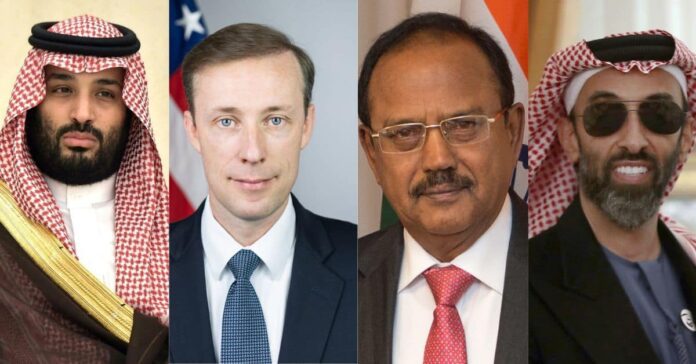National Security Advisors of the US, UAE, and India met with the Saudi crown prince to strengthen relations between the countries. The timing of the meeting is interesting as it happened soon after China made headlines in the Middle East’s diplomatic scene by mending ties between Iran and Saudi Arabia.
On May 7, 2023, the crown prince of Saudi Arabia, Mohammed Bin Salman, and the National Security Advisers of India, the UAE, and the US met in Riyadh to look into strategies to make West Asia more “interconnected” with the Indian subcontinent.
They discussed ways to “strengthen relations and ties between the three countries in a way that enhances growth and stability in the region,” according to the Saudi State news agency.
Similarly, the White House issued a statement stating that the Saudi crown prince, along with his Emirati and Indian counterparts, met with Jake Sullivan, US National Security Advisor, in Riyadh to “advance their shared vision of a more secure and prosperous Middle East region interconnected with India and the world.” Sullivan also reviewed significant progress on consolidating the now 15-month-long truce in Yemen and welcomed ongoing UN-led efforts to bring the war to a close.
According to the communiqué, he also said he was looking forward to having more discussions with Ajit Doval, Indian Security Advisor, outside of the Quad Summit in Australia this month. Furthermore, Sullivan praised the Crown Prince for Saudi Arabia’s assistance in assisting US citizens fleeing Sudan. The four delegates decided to maintain regular consultations and follow up on the key issues discussed throughout the day.
It’s interesting to note the timing of the situation as the four nations came together soon after China made headlines in the Middle East’s diplomatic scene by mending relations between Iran and Saudi Arabia, with Washington left out of the discussion. Riyadh and Beijing are also working together more closely on China’s Belt and Road infrastructure Initiative and also partnering on Vision 2030, a plan to reduce Saudi Arabia’s economic reliance on oil.
The fact that China imports 70% or so of its oil sets the stage for a relationship of mutual dependence. Beijing sees Riyadh as an important source of the stable energy supply it needs to fuel economic growth, while China offers Saudi Arabia a steady export market. While the Middle East has maintained its security engagements with Western nations, it is obvious they have also started to expand its economic relations with China.
Given this, it’s clear that the US intends to increase its presence in the Middle East to counter China’s influence. The leaders’ discussion centered on an infrastructure initiative called a “network of railways” to leverage shipping channels from ports to connect the Gulf with India. According to the US, It is a crucial initiative that the White House wants to support as China’s footprint in the region progresses.




